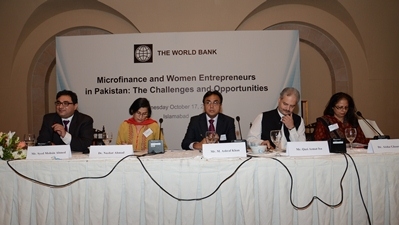“We manage to get permission [to start a business], but it’s the money that we don’t get.” This may be the experience of one Pakistani woman entrepreneur, but it is by no means unique. According to a new World Bank report, “Are Pakistan’s Women Entrepreneurs Being Served by the Microfinance Sector?”, less than 25 percent of Pakistan’s businesswomen are microfinance borrowers. Discriminatory lending practices are forcing Pakistan’s women entrepreneurs to look beyond microfinance providers for capital to start—and sustain—their businesses.
An economy thrives when women get the same opportunities as men. But when it comes to getting funding for their businesses, Pakistani women are faced with more challenges than opportunities -- even though the country’s microfinance environment is one of the world’s most progressive.
The report was launched at an event in Islamabad on October 17, 2012. “Access to finance remains one of the biggest challenges for Pakistani women who want to start and grow a business,” said Rachid Benmessaoud, World Bank Pakistan Country Director, in his opening remarks. “Strict guarantor requirements and the practice of offering business loan products exclusively to men have only widened the gap between Pakistani businesswomen and the microfinance sector.” With no other options, most businesswomen rely on savings, personal assets and family loans for capital.
The report also finds that microfinance loans do not always benefit women borrowers. Men who need loans, including those who have defaulted in the past, have begun to use women to access credit. Between 50 to 70 percent of microloans to women in Pakistan may actually be used by their male relatives. Even though they may not be the ones benefitting from the loans, women borrowers are wholly accountable for paying them back.
Microfinance loans for businesses are largely unavailable to women entrepreneurs, especially unmarried women who are considered high-risk borrowers. Microfinance providers enforce strict requirements that make it difficult for businesswomen to secure loans without men. Nearly 68 percent of women borrowers required a male relative’s permission in order to qualify for any kind of loan.
In addition, nearly all microfinance providers require women clients to provide two male guarantors in order to access a business loan, and at least one of the guarantors should be unrelated to the borrower. Finding unrelated male guarantors can be a challenge for Pakistani women micro entrepreneurs, who are often constrained by limited mobility and social barriers. Microfinance providers do not accept women guarantors for these loans.

